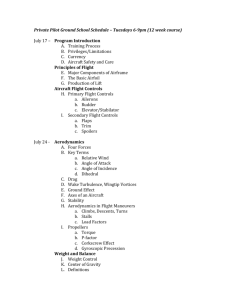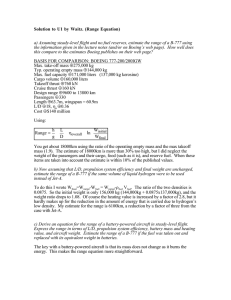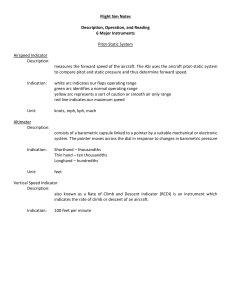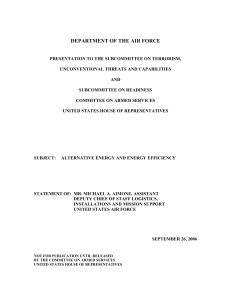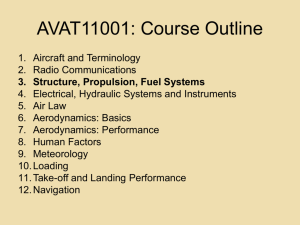(MEP) Safety Forum in Riga
advertisement
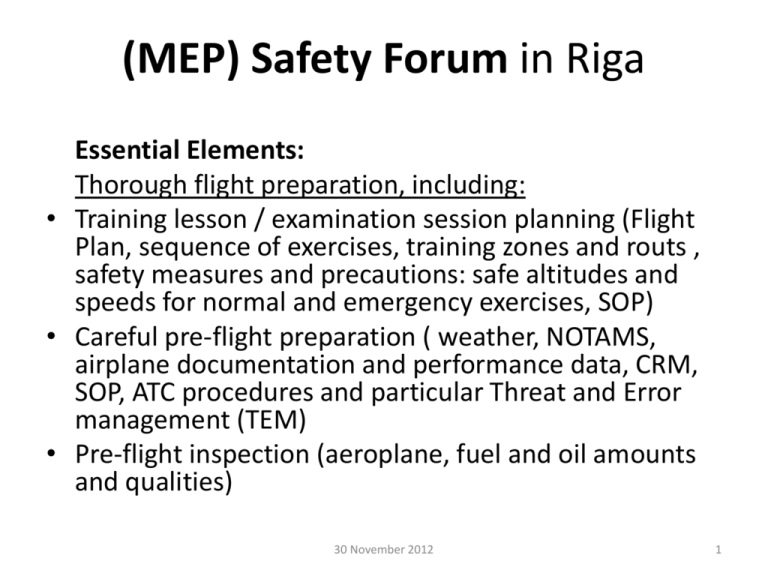
(MEP) Safety Forum in Riga Essential Elements: Thorough flight preparation, including: • Training lesson / examination session planning (Flight Plan, sequence of exercises, training zones and routs , safety measures and precautions: safe altitudes and speeds for normal and emergency exercises, SOP) • Careful pre-flight preparation ( weather, NOTAMS, airplane documentation and performance data, CRM, SOP, ATC procedures and particular Threat and Error management (TEM) • Pre-flight inspection (aeroplane, fuel and oil amounts and qualities) 30 November 2012 1 Essential Elements (cont) • Instructors, as well as applicants maintain awareness during Pre-flight preparation and flight: look- out, safe altitudes and speeds - depending of complicity of exercise • During emergency exercises (touch drills) as well as SOP in real emergency has to be applied similar like in commercial multi crew aircraft, including positive identification of actions being taken by pilot flying (student) and confirmation by pilot monitoring (instructor) – see example below. • Special attention has to be paid to use of carburettor heat 30 November 2012 2 Essential Elements (cont) • Examiner to avoid distraction by making test notes during skill tests/prof. checks – note making is required during simulator sessions but during actual flight, especially MEP flight, must be reduced to a minimum to avoid examiner distraction. • Holding blue line speed is the ONLY acceptable speed to be taught for climb during engine out and should be considered as minimum for all other engine out flight regimes. Performance of light MEP aircraft may be degraded to non-existent levels at other speeds. These aircraft do not have the performance capabilities of JAR/FAR 25 certified aircraft and as such instructors and examiners should be continually vigilant of the very small margin between this speed and Vmca. Failure to accurately maintain speed may result in a rapid loss of control. 30 November 2012 3 Essential Elements (cont) • Cost savings may result in non-optimal aircraft and procedure use. All personnel must be vigilant and regulators should bear this in mind! • Attention! The issue of TEM must be taken into consideration during flight planning, preflight preparation and during actual training/examination flights 30 November 2012 4 General points for our three Baltic States Regarding fuel: • The lack of ready availability of controlled fuels for General Aviation is a serious problem in all 3 Baltic States. AVGAS is the only fuel that should be used in Lycoming and Continental engines. • Where practicable fuel tanks should be filled prior to night stop in order to reduce instance of water condensation / ice in tanks. • APPROVED fuel additives may be beneficial during winter operations (e.g. Compound 06) • Before EACH flight, and after ANY refueling, a full “cup” of fuel must be drained from EACH fuel drain point. 30 November 2012 5 General points for our three Baltic States (cont) • Example student - instructor CRM: • Student: ,,confirm left engine fuel valve off, touch drill only (if simulated)!” • Instructor ,, left engine fuel valve confirmed, touch drill only (if simulated))!” • Only after this student can produce imitation of fuel valve shutting (touch drill) or shut down in real emergency 30 November 2012 6 Latvia Specific Considerations: • • • Preparation/revision of training zones Giving consideration to area where forced landing may be executed Safety conferences conducted 2 times per year 30 November 2012 7



